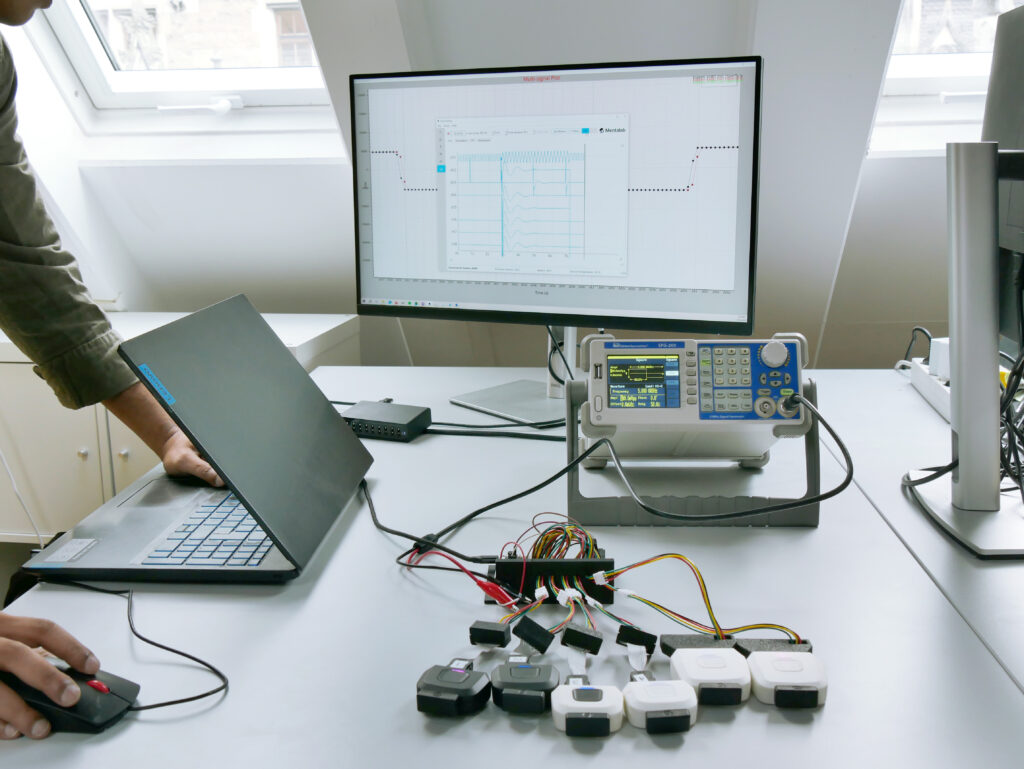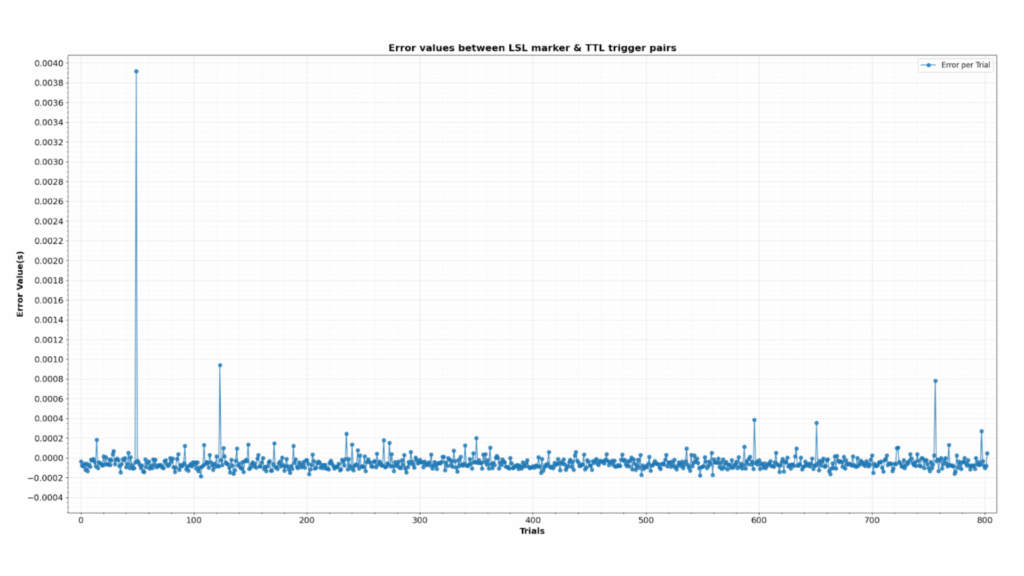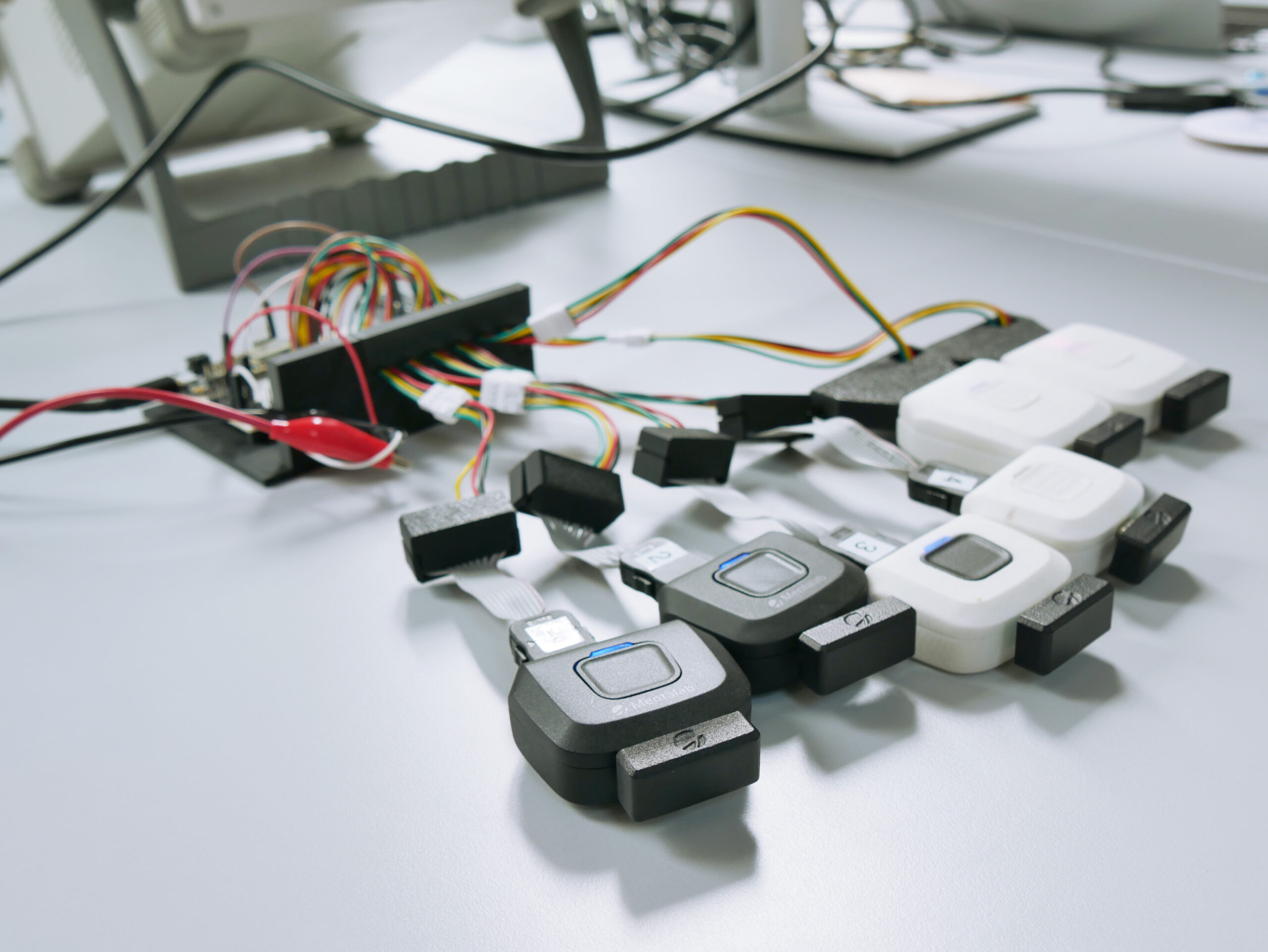In this post, we offer a transparent look behind the scenes: how we designed and executed our testing setup to validate Hypersync’s EEG synchronization accuracy and reliability under real-world conditions.
In many EEG and ExG experiments, precise synchronization between multiple acquisition devices and the experimental computer is essential. Achieving precise synchronisation is essential not only for Hyperscanning studies, in which brain signals are recorded from several participants at the same time, for instance, to study social interaction. Similarly, users interested in synchronising EEG with peripheral ExG sensors, such as an ECG system worn on the chest, want synchronised data, without involving long cables reaching along the body of the participant. Not least, the same problem arises when conducting fully wireless event-related potential (ERP) studies.
Mentalab Hypersync addresses this challenge by providing sub-millisecond wireless synchronization through a single central host system. Fully compatible with the Lab Streaming Layer (LSL) framework [1], Hypersync enables seamless time alignment across multiple data acquisition devices and experimental computers.

The test setup
To test EEG synchronization accuracy, we used the Lab Streaming Layer (LSL) validation procedure [2], measuring the temporal offset between a hardware-defined ground truth event and a software-generated LSL marker event. Software events occur with irregular timing, while hardware events correspond to voltage transitions on cables connected directly to the Mentalab hardware.
The hardware event is triggered via a wired USB connection, which sends a transistor-transistor-logic (TTL) pulse to the Mentalab ExG amplifiers’ wired trigger inputs. A dedicated computer process initiates both hardware and software events sequentially, ensuring synchronized stimulus delivery. We designed a dedicated hardware setup for this purpose, which can be expanded modularly to accommodate additional amplifiers as needed. Each amplifier processes the incoming signals and transmits them wirelessly to the Hypersync host for synchronization and recording. All resulting data streams – from both the hardware and software sources – are recorded using LabRecorder for subsequent analysis.

Results: EEG Synchronization
The results are calculated from the XDF files recorded using LabRecorder during the test. For each hardware and software event pair, the error value between the LSL markers and the analog signal was computed. Summary statistics for the error values were computed across approximately 800 trials over one hour. A zoomed-in and zoomed-out view of the error value and frequency distribution plot is shown below. The mean and standard deviation of the error values are in microseconds and suggest a very low jitter well within the sub-millisecond range. In fact, about 90% of the data is within +- 200 microseconds. The results were also validated with CSV file recordings, multiple sampling rates, and an analogue signal-based trigger generator.


Learn more about Mentalab Hypersync and our products.
References
- Kothe, C., Shirazi, S. Y., Stenner, T., Medine, D., Boulay, C., Grivich, M. I., Artoni, F., Mullen, T., Delorme, A., & Makeig, S. (2025). The lab streaming layer for synchronized multimodal recording. Imaging Neuroscience, 3, IMAG.a.136. https://doi.org/10.1162/IMAG.a.136
- https://sccn.ucsd.edu/download/mgrivich/LSL_Validation.html
- Ayrolles, A., Brun, F., Chen, P., Djalovski, A., Beauxis, Y., Delorme, R., Bourgeron, T., Dikker, S., & Dumas, G. (2021). HyPyP: A Hyperscanning Python Pipeline for inter-brain connectivity analysis. Social Cognitive and Affective Neuroscience, 16(1–2), 72–83. https://doi.org/10.1093/scan/nsaa141
- Barraza, P., Dumas, G., Liu, H., Blanco-Gomez, G., van den Heuvel, M. I., Baart, M., & Pérez, A. (2019). Implementing EEG hyperscanning setups. MethodsX, 6, 428–436. https://doi.org/10.1016/j.mex.2019.02.021
- Czeszumski, A., Eustergerling, S., Lang, A., Menrath, D., Gerstenberger, M., Schuberth, S., Schreiber, F., Rendon, Z. Z., & König, P. (2020). Hyperscanning: A Valid Method to Study Neural Inter-brain Underpinnings of Social Interaction. Frontiers in Human Neuroscience, 14. https://doi.org/10.3389/fnhum.2020.00039
- Turk, E., Vroomen, J., Fonken, Y., Levy, J., & van den Heuvel, M. I. (2022). In sync with your child: The potential of parent–child electroencephalography in developmental research. Developmental Psychobiology, 64(3), e22221. https://doi.org/10.1002/dev.22221
- Zamm, A., Loehr, J. D., Vesper, C., Konvalinka, I., Kappel, S. L., Heggli, O. A., Vuust, P., & Keller, P. E. (2024). A practical guide to EEG hyperscanning in joint action research: From motivation to implementation. Social Cognitive and Affective Neuroscience, 19(1), nsae026. https://doi.org/10.1093/scan/nsae026
- https://github.com/amisepa/BrainBeats
- Cannard, C., Wahbeh, H., & Delorme, A. (2024). BrainBeats, an Open-Source EEGLAB Plugin to Jointly Analyze EEG and Cardiovascular Signals (p. 2023.06.01.543272). bioRxiv. https://doi.org/10.1101/2023.06.01.543272
FAQ
How do you synchronize two or more EEG devices for hyperscanning experiments?
Mentalab Hypersync synchronizes multiple EEG systems by connecting all Explore amplifiers and experimental computers to a single wireless timing host. Each device streams its data through the Lab Streaming Layer (LSL), and Hypersync aligns the timestamps so all EEG data share the same clock with sub-millisecond precision, even when participants are physically separated.
Can I synchronize EEG with ECG/EMG/EOG (multimodal ExG)?
Yes. Hypersync can time-align the EEG with other physiological signals, such as ECG, EMG, or EOG, in real time, without using long trigger cables.
Can you run wireless ERP experiments (e.g., P300, flanker task) without losing timing precision?
Yes. Hypersync maintains sub-millisecond timing accuracy in wireless event-related potential (ERP) studies. This means you can reliably capture latency-sensitive components such as the P300 or N200 – even during movement.
How do you validate synchronization accuracy in LSL recordings (e.g., using XDF timing error analysis)?
You can validate synchronization by comparing hardware trigger timestamps to LSL markers in the XDF file and computing timing error distributions to confirm sub-millisecond latency and jitter.
What research applications use synchronized multi-device EEG?
EEG hyperscanning (social interaction, joint action), multimodal EEG-ECG “brainbeats,” mobile/wireless ERP (P300, flanker), and any LSL-based multi-device experiment that needs precise timing.
How accurate is Mentalab Hypersync (latency and jitter)?
In ~800 trials over ~1 hour, ~90% of event-pair errors were within ±200 µs after subtracting a fixed 3.6 ms latency; overall jitter is well within the sub-millisecond range.




